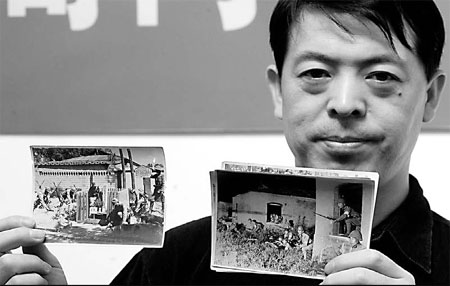 |
|
Zhan Hongge yesterday showed photos he collected in Harbin, Heilongjiang Province, which recorded the Sept 18 Incident in 1931. The photos are among the first found on that event and were donated by Zhan to the Sept 18 Incident Museum. |
A group of Chinese who were victims of forced labor by Japanese aggressors vowed on the eve of the 77th anniversary of Japan's invasion of northeast China "never to give up" seeking compensation from Japan outside the courts.
Eighty of the forced laborers and family members of the victims who died from the invasion gathered in Jinan, provincial capital of Shandong, to discuss the issue on Wednesday.
The Sept 18 Incident, also known as the Manchurian Incident in Japanese, marks the start of Japan's armed invasion of the region.
From 1943 to 1945, about 40,000 Chinese were captured and taken by the invaders to Japan, forcing them to work at mines and construction sites. About 7,000 died from the ordeal. The rest were repatriated after the war.
The victims and their families have filed repeated lawsuits on the issue over the years but failed to make any headway.
Li Liangjie, 83, said that while most of the compensation lawsuits had failed, the group will not give up looking for other means to resolve the issue.
Foreign Ministry spokeswoman Jiang Yu supported the claim at yesterday's regular press briefing.
"The (forced labor) problem was one of the felonies Japan committed during its invasion into China," she said. "We hope Japan can face it seriously and properly handle the just claim from the Chinese people."
The forced laborers began their compensation lawsuits in the early 1990s. A member of the group, Liu Lianren, was forcibly taken to Japan in September 1944 from his home in Shandong through Qingdao, along with 800 others.
Liu was reportedly forced to work at a mine in the northern Japanese island of Hokkaido. He later escaped from the island with four other laborers in April 1945 and continued to hide in the mountains before being found in February 1958.
In 1996, Liu filed a suit for Japan to compensate him for his suffering. His eldest son took over the fight after Liu died in 2000 at the age of 87.
In 2001, the Tokyo District Court ruled that Japan should compensate Liu. The Tokyo High Court rejected the ruling in 2005.
"Like Liu, Chinese laborers filed more than 20 lawsuits, but most of them lost their cases," said Fu Qiang, a lawyer representing Liu.
"There is a bleak future for the compensation via lawsuits," he said. The lawyer's team has being considering other means, such as negotiation, to seek closure on the issue.
"We need justice and will keep working on the compensation problem to the very end," said Lu Zhiying, daughter of forced laborer Lu Xuewen, who died five years ago.
The laborers and their families said they hope more Chinese lawyers will join them to build a 500-strong legal team.
Deng Jianguo, head of their legal team, said the number of Chinese survivors currently stood at 700, all in their 70s and 80s.
"We hope the Japanese government and the enterprises that used the forced laborers will make an apology and give compensation as soon as possible," he said.
(China Daily, Xinhua News Agency, September 19, 2008)